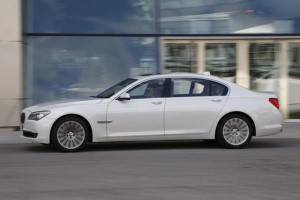
The 2010 model BMW 760Li introduces a fourth-generation V-12 engine to the new 7-Series line-up.
A new V-12 engine is something that gets my attention right away. Not just because I like big engines, but because the guys in Bavaria know perfectly well how to develop and build them.
On my way to Munich, for my first drive in the all-new, 2010 BMW 760Li, I wondered if, in this era of downsizing, there would still be buyers for the 7-Series with such a powerful engine. Isn’t a V-8 good enough?
BMW never reveals its internal sales forecasts, but during a media briefing, the board member, Dr. Klaus Draeger, was very upbeat about the chances for the flagship sedan’s most expensive variant, despite the seeming realities of a market in recession atop growing emphasis on fuel efficiency.
The 750i and 750Li, the twelve-cylinder versions of the former generation did well: between 2002 and 2008 nearly 12,000 units were sold worldwide. In both the U.S. and China, in fact, the 12-cylinder models accounted for 23% of total 7-Series sales, while in other key markets that ran anywhere from 6% to 15%. But, in fact, company officials admit demand is likely to slip with the 760, if for no other reason changing regulations. In China, for example, new taxes on products with engines larger than 4-liters will add about $45,000 to the price of the big Bimmer.
Still, there are those who say life isn’t complete without owning a 12, and, one might assume, having the cash to buy one. BMW has been ready to provide that life-sustaining technology since 1987, when it launched the 750i, its first 12-cylinder model since World War II. It delivered a then-stunning 300 horsepower and accelerated the big 7-er from 0-100 KmH (0 – 60 mph) in just 7.4 seconds, with fuel economy of about 17 mpg combined.
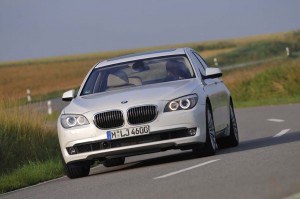
BMW completely updated the flagship 7-Series for 2009. Now it introduces an all-new V-12 to power the ultimate version of the 7-er.
The second-generation 12, in 1994’s 750i, bumped that to 326 horsepower, swapped the 4-speed automatic for a 5, and cut 0-100 KmH times to just 6.6 seconds, even though fuel economy increased by over 1 mpg.
The third-generation V-12 was fitted into the 750Li, in 2003. Fuel consumption went the wrong direction, falling to 13.4 mpg, arguably due to the car’s extra heft, but the performance numbers also jumped, to 445 horsepower and, with the new 6-speed automatic, 0 – 100 times fell again, to 5.5 seconds.
The newest iteration is a 6-liter powerplant. It features TwinPower turbocharging, high precision direct injection and double-Vanos camshaft adjustment, and mated to the latest 8-speed gearbox, it puts out a boggling 544 horsepower and 553 lb-ft of torque, a whopping 22/25% improvement, respectively. For those who cross their eyes at such numbers, BMW also points out that fuel economy is now equivalent to 18.2 mpg, while CO2 emissions are cut nearly 9%, to 299 grams per kilometer, one heck of a long way from meeting European Co2 regulations of 120 grams, which if past practices are an indicator of the future, BMW will buy its way out of.
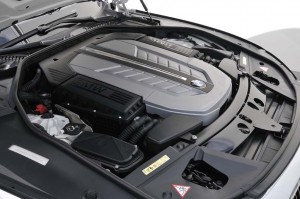
The heart of the matter: the fourth-generation V-12 makes 540 horsepower and 553 lb-ft of torque.
Isn’t this the company that labelled its products, at the recent Geneva Motor Show, “Efficient Dynamics,” and which spends plenty of time, effort and money, promoting its environmental efforts? Yes, but Draeger is quick to argue that, “Positioning in the top segment is important for the brand, while the relatively small market segment has a very low impact on worldwide emissions.”
In fact, BMW was able to deliver a mix of performance and improve mileage by integrating a slew of EfficientDynamic technologies, such as Brake Energy Regeneration, on-demand operation of the electrical water pumps and the volume flow-controlled oil pump. BMW also used aluminium for the hood, roof and doors to keep the weight to some 4,800 lbs.
Our first test with the 760Li in Bavaria proved to be an experience in serenity. In the cockpit of the luxury limo, you immediately sense a relaxed atmosphere. The smell of the beautiful leather, the well balanced color and trim combination, the comfortable seat, make you feel instantly at ease.
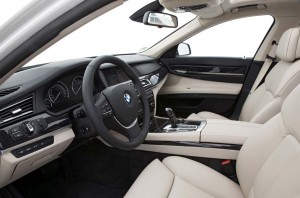
For all its power, the 2010 BMW 760Li puts a premium on luxury features, from the lavish interior finish to the reclining rear massage seats.
Driving at Autobahn speeds – limited to 155 mph – gives a completely in-control feeling. The engine runs quietly in the background, the revs low and the 8-speed transmission shifting almost imperceptibly. That is, if you are in Comfort or Normal mode.
As soon as you choose Sport or Sport Plus, the tach jumps up by 300 revs and the transmission shifts are decidedly more aggressive. Then you can break loose, but in a sophisticated manner, of course, as the engine will never be screaming when doing it’s sporty duty and bringing all that power to the pavement via the 19-inch wheels and tires.
Stretched out in back, with the massage seats reclined, you might not even notice. The 760Li is big, but its handling is so precise and nimble that even up front you are largely oblivious of its length and mass, even charging down winding country roads.
And should you let your eyes wander off the road to glance at the old castle that you are passing, the Lane Departure Warning system sounds an alert, returning your attention to the job at hand.
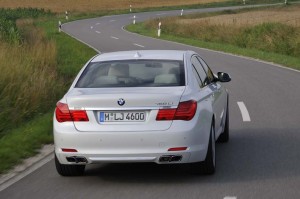
Despite its bulk, the new 2010 BMW 760Li shows a surprising amount of agility on even the must demanding country roads.
The North American market will only get the long-wheelbase 760Li, which will arrive in September. The base price is $136.600 plus $ 825 destination and handling. Presumably a heft gas guzzler fine for law violators is on top of that.
The extended standard equipment includes an 8-speed automatic transmission, heated sport steering wheel, integral active steering, active roll stabilization, soft-close doors and automatic trunk gate closing, side and rear view cameras, active front seats, front and rear ventilated seats, heated comfort seats in the rear, ceramic controls (BMW is the first car manufacturer to use this material), lane departure warning and active blind spot detection, head-up display, high beam assistant, iPod/USB adapter, Sirius satellite radio and a premium sound system with 6-disc DVD changer.
Ostensibly, the big 760Li is aimed at the chauffeur-driven crowd. It’s nice to know that your staff can have some real fun while you’re hard at work in the back seat. Then again, BMW says a lot of folks who can afford a chauffeur prefer to drive themselves around. That’s something we can easily understand.
Oh, and a footnote is due here. Late last year, BMW and Mercedes announced plans to buy parts together, hoping to trim costs. Since then, various sources suggest that not only will BMW use its new V-12 in the 760, and the upcoming Rolls-Royce , but that it may also resurface under the hood of an updated Maybach, the uber-flagship of Mercedes’ parent, Daimler AG. There are also indications Aston Martin, sold last year to a Kuwaiti investment consortium, might also opt for the Bimmer 12 in future models, rather than trying to upgrade its own V-12.
